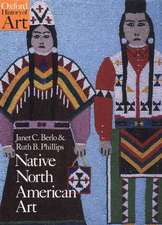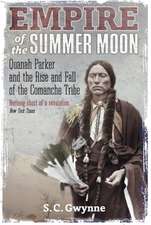Textile Traditions of Mesoamerica and the Andes: An Anthology
Editat de Margot Blum Schevill, Janet Catherine Berlo, Edward B. Dwyeren Limba Engleză Paperback – oct 1996
Preț: 375.00 lei
Nou
Puncte Express: 563
Preț estimativ în valută:
71.75€ • 75.12$ • 59.37£
71.75€ • 75.12$ • 59.37£
Carte tipărită la comandă
Livrare economică 07-21 aprilie
Preluare comenzi: 021 569.72.76
Specificații
ISBN-13: 9780292777149
ISBN-10: 0292777140
Pagini: 527
Ilustrații: 61 b&w Photos; 31 Figures
Dimensiuni: 140 x 216 x 35 mm
Greutate: 0.45 kg
Ediția:Univ of Texas P
Editura: University of Texas Press
Colecția University of Texas Press
ISBN-10: 0292777140
Pagini: 527
Ilustrații: 61 b&w Photos; 31 Figures
Dimensiuni: 140 x 216 x 35 mm
Greutate: 0.45 kg
Ediția:Univ of Texas P
Editura: University of Texas Press
Colecția University of Texas Press
Notă biografică
Margot Blum Schevill is a textile consultant for the P. Hearst Museum of Anthropology at the University of California, Berkeley, and the Fine Arts Museums of San Francisco. Janet Catherine Berlo is Professor of Art History at the University of Missouri-St. Louis. Edward B. Dwyer is Associate Provost at the Rhode Island School of Design.
Cuprins
- Preface to the 1996 Edition
- Contributors
- I. Introduction: The Communicative Power of Cloth and Its Creation (Margot Blum Schevill)
- II. Mesoamerica
- Chapter One. Spinning and Weaving as Female Gender Identity in Post-Classic Mexico (Sharisse D. McCafferty and Geoffrey G. McCafferty)
- Chapter Two. Communicative Imagery in Guatemalan Indian Dress (Cherri M. Pancake)
- Chapter Three. A Line at a Time: Innovative Patterning in the Isthmus of (Isthmian) Mexico (Pamela Scheinman)
- Chapter Four. Dress and Civil-Religious Hierarchy in Sololá, Guatemala (Guisela Mayén)
- Chapter Five. Dress and the Human Landscape in Guatemala: The Case of Tecpán, Guatemala (Carol Hendrickson)
- Chapter Six. Woman's Costume as a Code in Comalapa, Guatemala (Linda Asturias de Barrios)
- III. Central Andes of South America
- Chapter Seven. We Are Sons of Atahualpa and We Will Win: Traditional Dress in Otavalo and Saraguro, Ecuador (Lynn A. Meisch)
- Chapter Eight. Regional Dress of the Colca Valley, Peru: A Dynamic Tradition
- (Blenda Femenias)
- Chapter Nine. Nature Versus Culture: The Image of the Uncivilized Wild-Man in Textiles from the Department of Cuzco, Peru (Lee Anne Wilson)
- Chapter Ten. Clothes and Identity in the Central Andes: Province of Abancay, Peru (Raquel Ackerman)
- Chapter Eleven. Ethnic Dress and Calcha Festivals, Bolivia (Mary Ann Medlin)
- IV. Weaving and Dyeing Technology
- Chapter Twelve. Dual-Lease Weaving: An Andean Loom Technology (Ed Franquemont)
- Chapter Thirteen. Resist Dyeing in Mexico: Comments on Its History, Significance, and Prevalence (Virginia Davis)
- Chapter Fourteen. The Ikat Shawl Traditions of Northern Peru and Southern Ecuador (Laura Martin Miller)
- Chapter Fifteen. The Dyes Used in Guatemalan Textiles: A Diachronic Approach (Robert S. Carlsen and David A. Wenger)
- V. The Marketing of Textiles
- Chapter Sixteen. Export Markets and Their Effects on Indigenous Craft Production: The Case of the Weavers of Teotitlán del Valle, Mexico (Lynn Stephen)
- Chapter Seventeen. The Marketing of Maya Textiles in Highland Chiapas, Mexico (Walter F. Morris, Jr.)
- VI. Conclusion
- Chapter Eighteen. Beyond Bricolage: Women and Aesthetic Strategies in Latin American Textiles (Janet Catherine Berlo)
- Additional References
- Glossary
- Index
Recenzii
This is a vital, worthwhile book that fills an important need and is very much in phase with current anthropological thinking.... This anthology will be particularly rewarding to readers interested in traditional indigenous communities and the insight gleaned from a detailed consideration of cloth and clothing.
The essays in this book are informative and a pleasure to read. Collectively they make the reader want to journey to Mesoamerica and the Andes to view in person the cloth and clothing of the indigenous communities.
Descriere
In this volume, anthropologists, art historians, fiber artists, and technologists come together to explore the meanings, uses, and fabrication of textiles in Mexico, Guatemala, Ecuador, Peru, and Bolivia from Precolumbian times to the present.












